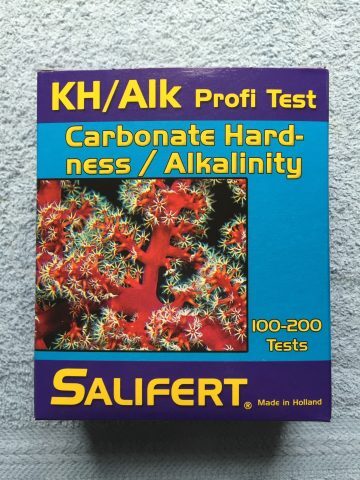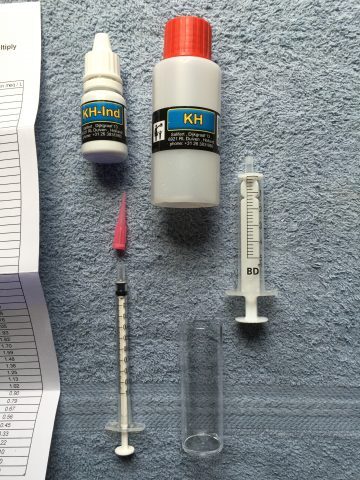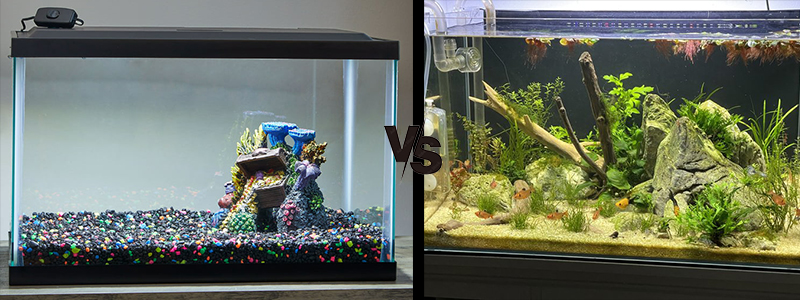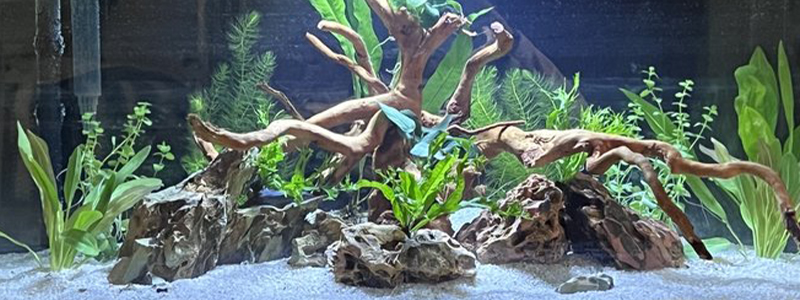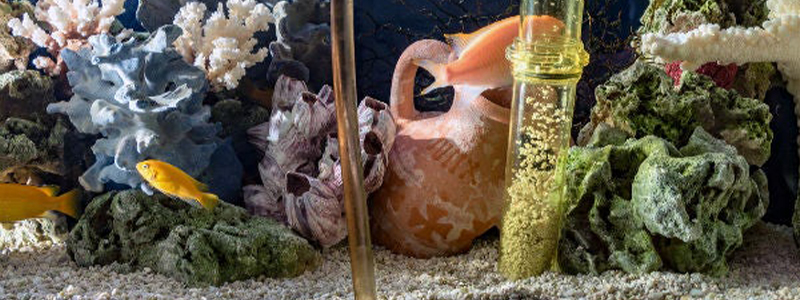Let’s take a quick, up-close look at the Salifert alkalinity test kit and see how good — or bad, it really is…
The Salifert alkalinity test kit is the second alkalinity test kit I’ve used since setting up my saltwater aquarium five months ago.
Here’s a look at how it works… what I really like about it… and what I don’t like about it…
Disclosure: This article contains affiliate links. When you follow a link to purchase the products, I sometimes earn a commission, at no additional cost to you. Read my full disclosure here.
The Salifert alkalinity test kit in action:
The test includes an indicator fluid, a titration fluid, a test vial, a 5ml syringe, a 1ml syringe, a precision tip for the 1ml syringe, and instructions.
As you can guess, that means it involves dispensing two fluids.
The testing process is straightforward:
- Use the 5ml syringe to add 4ml of tank water into the test vial
- Add 4 drops of the KH-Ind fluid to the test vial
- Fit the precision tip onto the 1ml syringe
- Fill the 1ml syringe with 1ml of the KH (titration) fluid
- Dispense a drop of KH fluid into the vial, swirl the test vial for a second or two… add another drop… swirl… and continue until the water changes from blue to either an orangish-red or pink color – whichever comes first. (If you know roughly where you expect your alk to be, you can add 60% – 70% of the fluid at once, then switch to drop by drop in order to save time.)
The key is recognizing the color change…
Here, have a look:
After adding 4 drops of KH-Ind, the test starts out a nice, vivid BLUE…
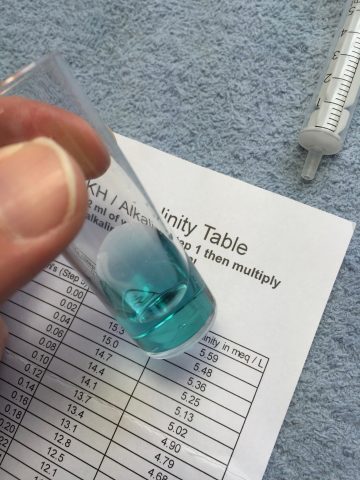
After adding about 0.5 ml of the KH fluid from the 1 ml syringe, it’s beginning to darken to purple…
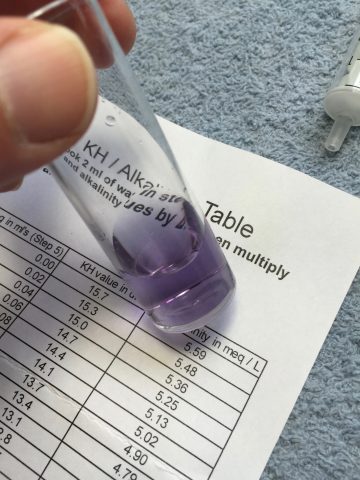
Getting closer, but still not orange-red or pink…
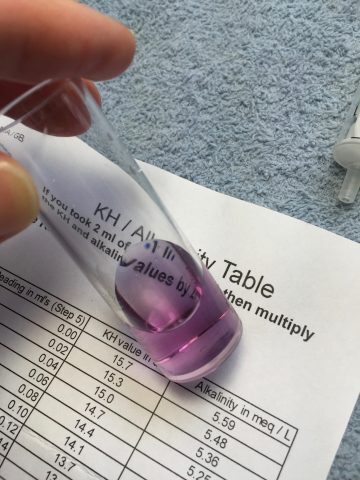
And there it is – a nice rosy pink:
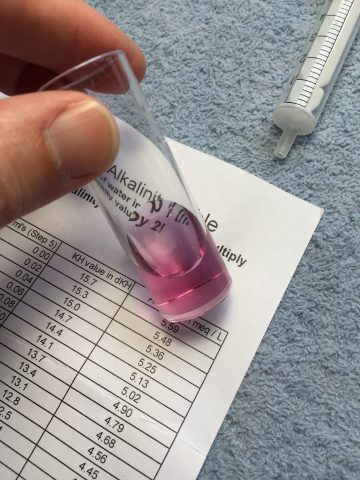
Once it turned the nice rosy pink you see in the picture, I read the 1ml syringe to see what mark the bottom of its black plunger was at — it read 0.42 ml (meaning 0.42ml of KH fluid was still in the syringe).
A quick look at the table on the instruction sheet shows that a reading of 0.42 ml equates to alkalinity of 8.9 dKH or 3.19 meq/L.
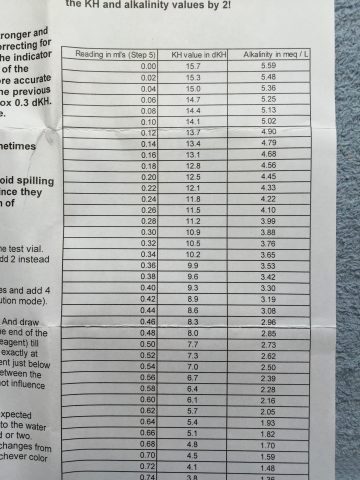
That’s it, that’s all there is to it.
All in all, it took me two, maybe three minutes to complete the test.
The other alk test I used before this one was part of the Red Sea Marine Care Test Kit set which also included tests for ammonia, nitrite, nitrate, and pH.
The alk test in that kit involves just adding drops of just one chemical into 5ml of tank water and watching for the color to change from blue to either green or yellow.
For my eyes, the change from blue to either green or yellow was a little more distinct than the blue to purple to pink of the Salifert alkalinity test – but just barely.
After using the Salifert kit two or three times I now have no problem recognizing the correct color shift.
If it turned green the number of drops equaled the alkalinity reading in dKH units. If it turned yellow you had to subtract 0.5 and that was your reading in dKH units. So, if the ninth drop turned the test water from blue to green, the alkalinity was 9 dKH. If the ninth drop turned it from blue to yellow, the alk was 8.5 dKH.
In other words, it only had a resolution of 0.5 dKH.
Since I only have two SPS corals in my tank at the moment – with all the others being soft corals or LPS corals I didn’t really think the higher resolution of the Salifert alkalinity test – would matter much…
I also thought the ease and quickness of just adding between five to ten drops of one fluid to a test vial would be much less hassle versus having to go drop by drop for the final portion of the Salifert testing.
But now that I’ve actually tried it, I find I like the finer resolution of the Salifert alkalinity test kit much better.
There is definitely less guesswork to it.
And now that I’ve recently begun dosing 2-part for all of my LPS and the few SPS, the more accurate reading is making it much easier to dial in the daily amount of 2-part that best suits the needs of my tank.
Bottom line: I have been VERY pleasantly surprised by the Salifert alkalinity test kit. I find the improved resolution of the results well worth the extra 90 seconds it takes compared to the test kit I was using before.
If you like to give it a try for yourself, you can grab a test kit for 100-200 tests at Amazon.com or almost any online or local saltwater aquarium store.
If you’d like to read more about the importance of alkalinity in saltwater aquariums, check out this article by Randy Holmes-Farley at Reefkeeping.com.

